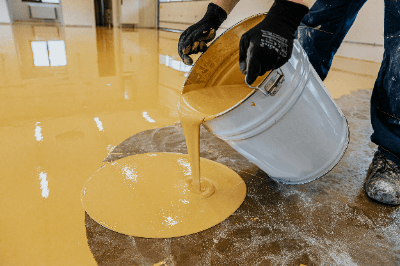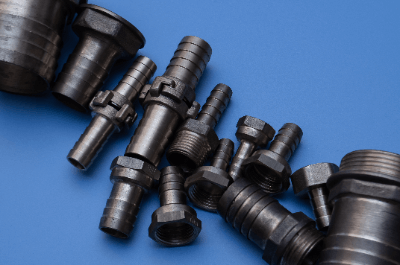What Is Modified Epoxy Resin Paint?
 Modified Epoxy Resin Paint is a type of epoxy resin paint. It is a paint using a resin modified by adding a modified resin to epoxy resin or by modifying the resin backbone of epoxy resin.
Modified Epoxy Resin Paint is a type of epoxy resin paint. It is a paint using a resin modified by adding a modified resin to epoxy resin or by modifying the resin backbone of epoxy resin.
The typical method of denaturation is to add the function of a denaturant to epoxy resin by bridging epoxy resin prepolymers with a bisphenol A skeleton with another denaturant that has a function.
Uses of Modified Epoxy Resin Paint
Modified Epoxy Resin Paint is widely used as a rust inhibitor. Modified epoxy resins are characterized by excellent adhesion and permeability to other coating films. For this reason, they are sometimes used as a topcoat for old coatings that have already rusted.
Epoxy resins are especially used in repair work sites for condominiums and other buildings. Specifically, it is used to coat iron parts such as doors, doors, and antenna props.
Modified Epoxy Resin Paint can be used not only for residential applications, but also for painting large non-steel construction objects such as bridges, power plants, and concrete structures. They adhere to a variety of substrates and protect them from rust and water that can penetrate the surface.
Principle of Modified Epoxy Resin Paint
Epoxy resins are thermosetting resins that are cured by mixing prepolymers, which are polymers with multiple epoxy group residues, with multifunctional curing agents that have multiple functional groups, such as amines and acid anhydrides, that react with epoxy groups, resulting in dense cross-linking of the prepolymers. It has a strong network structure and is used as an engineering plastic. However, when used as-is in coatings, the coating film becomes hard and brittle, and adhesion to the adherend is weak.
Modified epoxy resins are used to modify the defects of epoxy resins. The purpose of modification is to incorporate a modifier into the epoxy resin prepolymer to express the properties of the functional groups in the modifier, to adjust flexibility by adjusting crosslink density, or to provide elasticity by combining with rubber or elastomer.
Such modification of modified epoxy resins increases their affinity for solvents and allows them to be used in a single component. Another feature of this process is that it improves the penetration of the rust layer, and thus provides superior characteristics as a coating.
Another feature is that the internal stress of the epoxy resin coating film is relieved, which improves adhesion to the substrate and the old coating film compared to normal epoxy resin coatings.
Types of Modified Epoxy Resin Paint
Modified Epoxy Resin Paint (MEP) is made from epoxy resins that have been modified with different types of modifiers. The main types of modified epoxy resins include urethane modified epoxy resin, polyester modified epoxy resin, rubber modified epoxy resin, and chelate modified epoxy resin.
1. Urethane Modified Epoxy Resin
Urethane-modified epoxy resins are epoxy resins with a urethane structure, and have excellent flexibility, high peel strength, toughness, and flexibility.
2. Rubber-Modified Epoxy Resins
Rubber-modified epoxy resins have excellent flexibility, impact resistance, and high peel strength.
3. Chelate-Modified Epoxy Resins
Chelate-modified epoxy resins have excellent corrosion resistance and adhesion.
Other Information on Modified Epoxy Resin Paint
Advantages and Disadvantages of Modified Epoxy Resin Paint
1. Advantages
The first advantage of modified epoxy resin paint is its high corrosion resistance. However, modified resins themselves do not have corrosion protection properties that inhibit the progression of rust on metals.
Physical factors such as relaxation of internal stress and reduction of water vapor permeability prevent the cause of rust from approaching the adherend metal, and as a result, high anticorrosion properties can be achieved.
Modified resins also have the advantage of improving the wettability of the paint on the surface to be coated, thus facilitating the wetting spread and penetration of the paint.
2. Disadvantages
The disadvantage of modified epoxy resin paint is that the range of colors that can be used is limited, and the modified resin migrates within the coating film, making it prone to discoloration and unevenness of color when used as a topcoat. Therefore, modified epoxy resin paint is rarely used on structures where appearance is important.
 Las bombas para tubos son un tipo de bomba utilizado para el trasiego de líquidos. Estas bombas constan de tres componentes principales: una pieza giratoria, un rodillo y un tubo. El motor hace girar el rodillo, lo que a su vez empuja el líquido a través del tubo, permitiendo su bombeo.
Las bombas para tubos son un tipo de bomba utilizado para el trasiego de líquidos. Estas bombas constan de tres componentes principales: una pieza giratoria, un rodillo y un tubo. El motor hace girar el rodillo, lo que a su vez empuja el líquido a través del tubo, permitiendo su bombeo. Los conectores de tubos se utilizan para unir tubos entre sí. El tipo más común es el conector cónico, que se inserta en el tubo y se aprieta para asegurar la unión. Además, existe el tipo “push-on”, que es fácil de manejar y se utiliza principalmente para gases a alta presión. Para minimizar las fugas, también se encuentran disponibles otros tipos de conectores de tubos.
Los conectores de tubos se utilizan para unir tubos entre sí. El tipo más común es el conector cónico, que se inserta en el tubo y se aprieta para asegurar la unión. Además, existe el tipo “push-on”, que es fácil de manejar y se utiliza principalmente para gases a alta presión. Para minimizar las fugas, también se encuentran disponibles otros tipos de conectores de tubos.